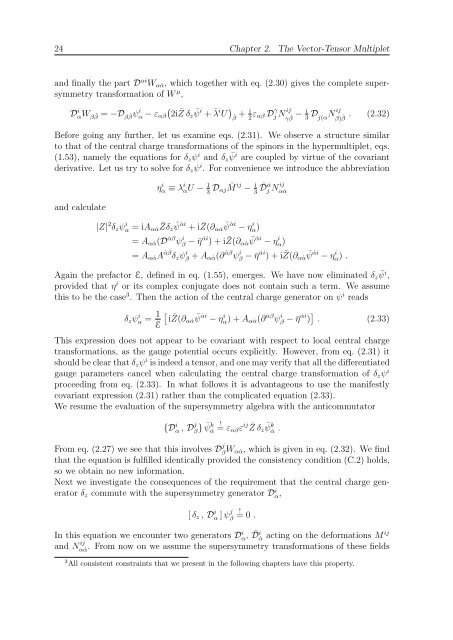N=2 Supersymmetric Gauge Theories with Nonpolynomial Interactions
N=2 Supersymmetric Gauge Theories with Nonpolynomial Interactions
N=2 Supersymmetric Gauge Theories with Nonpolynomial Interactions
Create successful ePaper yourself
Turn your PDF publications into a flip-book with our unique Google optimized e-Paper software.
24 Chapter 2. The Vector-Tensor Multiplet<br />
and finally the part DαiWα ˙α, which together <strong>with</strong> eq. (2.30) gives the complete supersymmetry<br />
transformation of W µ ,<br />
D i αWββ ˙ = −Dββ˙ ψ i <br />
α − εαβ 2iZ¯ δz ¯ ψ i + ¯ λ i U <br />
i<br />
˙β + 2εαβ D γ ij<br />
j N<br />
γ ˙ i −<br />
β 3 D ij<br />
j(αN β) ˙ . (2.32)<br />
β<br />
Before going any further, let us examine eqs. (2.31). We observe a structure similar<br />
to that of the central charge transformations of the spinors in the hypermultiplet, eqs.<br />
(1.53), namely the equations for δzψ i and δz ¯ ψ i are coupled by virtue of the covariant<br />
derivative. Let us try to solve for δzψ i . For convenience we introduce the abbreviation<br />
and calculate<br />
η i α ≡ λ i αU − 1<br />
3 Dαj ¯ M ij − i<br />
3 ¯ D ˙α j N ij<br />
α ˙α<br />
|Z| 2 δzψ i α = iAα ˙α ¯ Zδz ¯ ψ ˙αi + i ¯ Z(∂α ˙α ¯ ψ ˙αi − η i α)<br />
= Aα ˙α(D ˙αβ ψ i β − ¯η ˙αi ) + i ¯ Z(∂α ˙α ¯ ψ ˙αi − η i α)<br />
= Aα ˙αA ˙αβ δzψ i β + Aα ˙α(∂ ˙αβ ψ i β − ¯η ˙αi ) + i ¯ Z(∂α ˙α ¯ ψ ˙αi − η i α) .<br />
Again the prefactor E, defined in eq. (1.55), emerges. We have now eliminated δz ¯ ψ i ,<br />
provided that η i or its complex conjugate does not contain such a term. We assume<br />
this to be the case 3 . Then the action of the central charge generator on ψ i reads<br />
δzψ i α = 1 <br />
iZ(∂α ¯<br />
˙α<br />
E<br />
¯ ψ ˙αi − η i α) + Aα ˙α(∂ ˙αβ ψ i β − ¯η ˙αi ) . (2.33)<br />
This expression does not appear to be covariant <strong>with</strong> respect to local central charge<br />
transformations, as the gauge potential occurs explicitly. However, from eq. (2.31) it<br />
should be clear that δzψ i is indeed a tensor, and one may verify that all the differentiated<br />
gauge parameters cancel when calculating the central charge transformation of δzψ i<br />
proceeding from eq. (2.33). In what follows it is advantageous to use the manifestly<br />
covariant expression (2.31) rather than the complicated equation (2.33).<br />
We resume the evaluation of the supersymmetry algebra <strong>with</strong> the anticommutator<br />
{D i α , D j<br />
β } ¯ ψ k ˙α<br />
!<br />
= εαβε ij ¯ Z δz ¯ ψ k ˙α .<br />
From eq. (2.27) we see that this involves D j<br />
β Wα ˙α, which is given in eq. (2.32). We find<br />
that the equation is fulfilled identically provided the consistency condition (C.2) holds,<br />
so we obtain no new information.<br />
Next we investigate the consequences of the requirement that the central charge generator<br />
δz commute <strong>with</strong> the supersymmetry generator D i α,<br />
[ δz , D i α ] ψ j<br />
β<br />
!<br />
= 0 .<br />
In this equation we encounter two generators Di α, ¯ Di ˙α acting on the deformations M ij<br />
. From now on we assume the supersymmetry transformations of these fields<br />
and N ij<br />
α ˙α<br />
3 All consistent constraints that we present in the following chapters have this property.

















